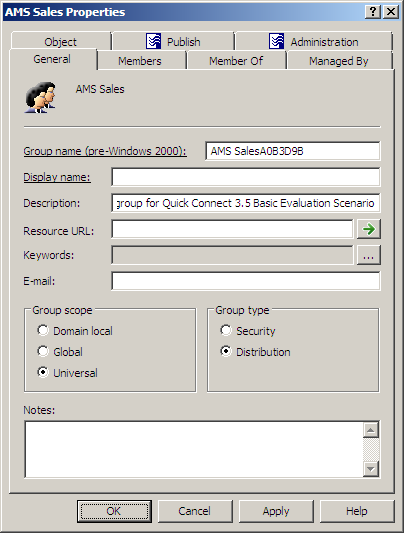You can copy Active Directory groups with the Active Roles Console.
To copy a group
-
In the Console tree, locate and select the folder that contains the group that you want to copy.
-
In the details pane, right-click the group you want to copy, then click Copy to start the Copy Object - Group wizard.
-
Follow the wizard pages to specify properties of the new group, such as the group name, pre-Windows 2000 name, description, membership list, and Exchange address settings.
-
(Optional) If you want to set values for additional properties (those for which the wizard pages do not provide data entries), click Edit Attributes on the completion page of the wizard.
-
After setting any additional properties for the copy of the group, click Finish on the completion page of the wizard.
NOTE: Consider the following when copying a group:
-
The behavior of the wizard pages may vary depending on the configuration of Active Roles policies. To determine whether a given item on a page is under the control of a certain policy, check the text label next to the item: the underlined text label indicates that some policy restrictions are in effect. Click the underlined text labels to examine the policies that govern the behavior of the wizard pages.
-
By default, some common properties are carried over to the copied group from the original group. Thus, the group membership list is copied from the original group, and can be modified in the Copy Object - Group wizard.
-
The group scope and group type are also copied from the original group, but these properties cannot be modified in the Copy Object - Group wizard. You can change these properties after the copy of the group is created. For instructions, see How to change group type and How to change group scope.
-
To locate the group that you want to copy, use the Find feature of Active Roles. Once you found the group, you can start the Copy Object - Group wizard from the Find dialog by right-clicking the group in the list of search results and clicking Copy.
To modify group properties, right-click the group and click Properties. You can make changes to group properties using the Properties dialog, shown in the following figure.
Figure 12: Modifying group properties

In the wizard, some property labels may be displayed as hyperlinks. The hyperlink indicates that Active Roles enforces certain policy restrictions on the property. To examine policy details, click the hyperlink: the policy information is displayed. For more information, see Getting policy-related information.
The policy information is also displayed whenever you supply a property value that violates a policy restriction. The wizard cannot proceed until you enter an acceptable value.
You can use the Properties dialog to view or modify any property of the object by navigating to the Object tab and clicking Advanced Properties. In the Advanced Properties window you can manage all properties, including those that cannot be accessed via the Properties dialog itself.
You can also display the Advanced Properties window by right-clicking the object and selecting All Tasks > Advanced Properties.
You can modify the properties of Active Directory groups with the Active Roles Console.
To modify group properties
-
In the Console tree, locate and select the folder that contains the group you want to modify.
-
In the details pane, right-click the group you want to modify, then click Properties.
-
Use the tabs in the Properties dialog to view or modify properties of the group.
-
If you want to view or modify additional properties (those for which the tabs in the Properties dialog do not provide data entries), navigate to the Object tab and click Advanced Properties.
-
After setting all the properties you want, click OK.
NOTE: Consider the following when modifying group properties:
-
The behavior of the user interface elements in the Properties dialog may vary depending on the configuration of Active Roles policies. To determine whether a given item on a tab is under the control of a certain policy, observe the text label next to the item: the underlined text label indicates that some policy restrictions are in effect. Click the underlined text labels to examine the policies that govern the behavior of the user interface elements.
-
To modify properties for multiple objects, press and hold CTRL, then click each object. Right-click the selection, then click Properties.
-
You can also access the Advanced Properties dialog for an object by right-clicking the account and selecting All Tasks > Advanced Properties.
-
To locate the object that you want to modify, use the Find function of Active Roles. Once you found the object, open the Properties page by right-clicking the object, and clicking Properties.
To change group scope or group type, right-click the group, click Properties, and go to the General tab in the Properties dialog, shown in the following figure. On the General tab, click the group type in the Group type area or click the group scope under Group scope.
Figure 13: Changing group type and group scope



